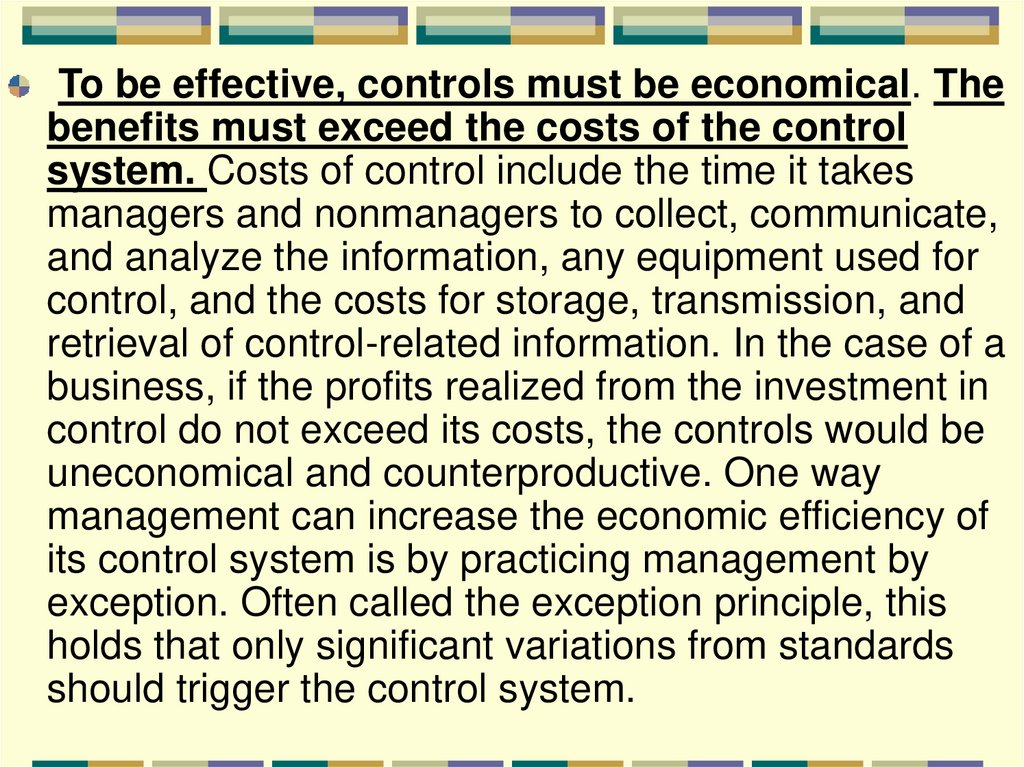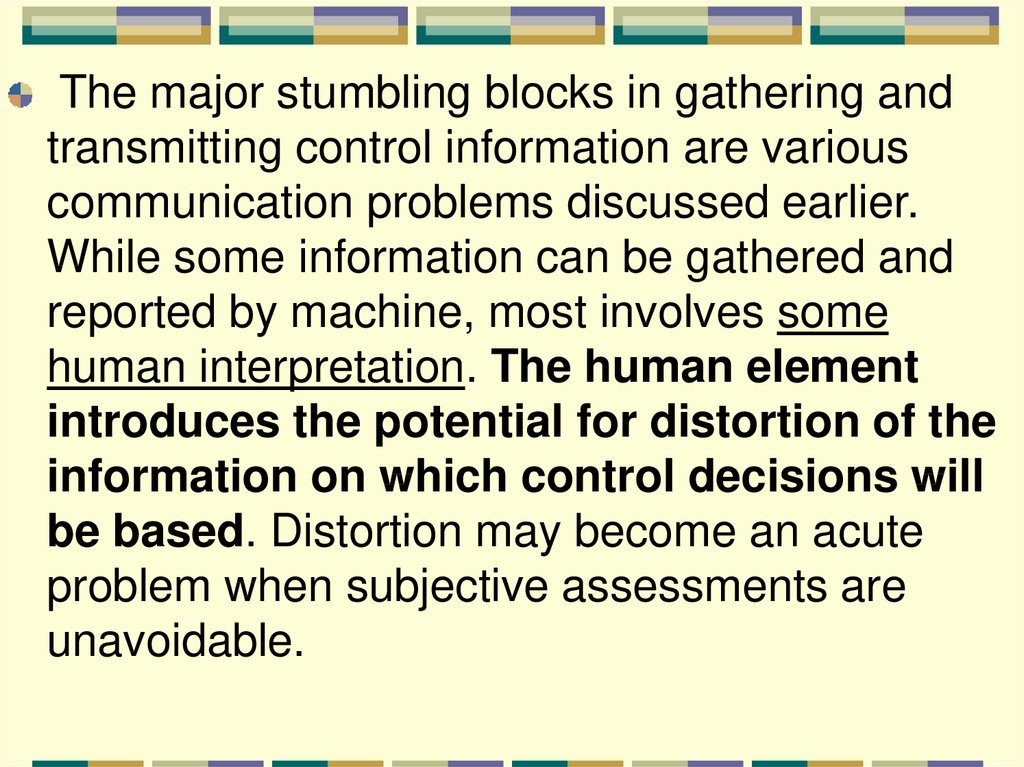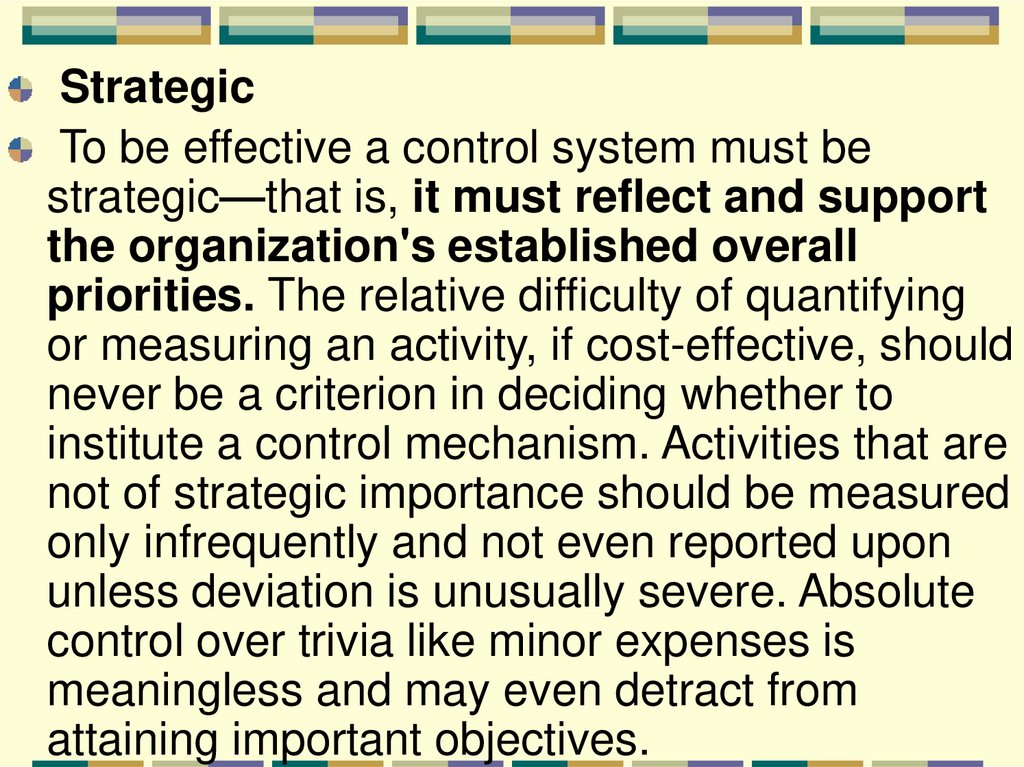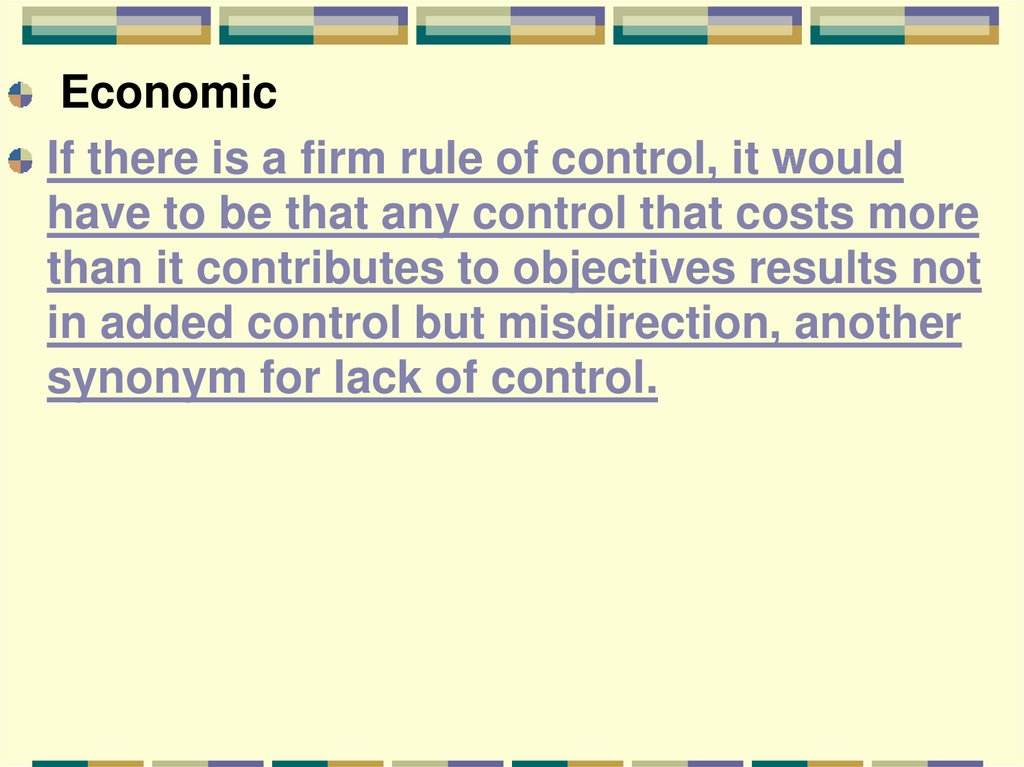Similar presentations:
Controlling. Nature and purpose of controlling
1. Controlling
2.
In earlier chapters we frequently mentioned theuncertainties of managing and the need to consider
management an unending process. Plans do not
always work out as intended. People do not always
accept delegation. Management cannot always
motivate people to work toward objectives. The
environment changes, and the organization must
adapt accordingly. You may have begun to wonder
how management determines whether it is, in fact,
attaining its objectives, how it detects its own and its
workers' mistakes, and how it determines when the
organization needs to adapt. The answer is through
the process of controlling. Controlling, in simple
terms, is the process by which management
determines whether its decisions are correct or
need to be modified.
3.
NATURE AND PURPOSE OFCONTROLLING
Control, like power, is a word that evokes
negative reactions. To many people control
connotes restraint—the leash on a dog,
coercion, confinement—images contrary to our
ideal of individual liberty. Because of this
preconception, controlling is one of the most
misunderstood management functions. If asked
to guess what control means to a manager,
people often respond with something like
keeping workers in line. This is correct in a
sense. One aspect of control is indeed ensuring
conformity of a sort.
4.
However, to think of controlling as simplyrestraining negative behavior and making
everyone to the line is to miss its primary
purpose in management. As a management
function:
Controlling is the process of ensuring that
the organization is attaining its objectives.
Controlling involves setting standards,
measuring actual performance, and taking
corrective action when performance deviates
significantly from standards.
5.
Why Control Is NecessaryManagers begin performing the control function
the very moment they formulate objectives and
establish an organization. This control is
essential if the organization is to succeed.
Without it chaos would reign, making group
effort of any complexity virtually impossible to
unify. Even more important, goals, plans, and
structure give the organization direction by
channeling and guiding work. Thus, control is
an inherent outgrowth of organization. This is a
major reason why Peter Drucker states, "The
synonym for control is direction."
6.
Uncertainty.Plans and organizational designs are only a
picture of what management would like the
future to hold. Many things could prevent this
"picture" from "developing" properly. Changes
in laws, social values, technology, competition,
and other environmental variables could make
plans that were feasible when formulated
unobtainable at a later time. In order to
anticipate and react to change, organizations
need an effective mechanism that can assess
its impact on the organization.
7.
In addition, even the best organizational designhas some negative consequences. Specialized
division of labor, for example, may introduce
problems of coordination, friction between work
groups, and dull and unmotivating jobs. A
design that looks good on paper or proved
successful in another time or place may not
accomplish as much as management hopes.
8.
Adding to the uncertainty of managing is thefact that much of the organization's work is
done by people. Unlike computers, people
cannot be programmed to perform tasks with
absolute precision. Despite the many recent
advances in understanding behavior at work,
managers are still a long way from being able to
predict consistently how people will respond to
instructions, authority, and leadership
9.
Crisis Prevention.Mistakes, problems in the internal variables, and misjudgment in predicting the future or people tend to
compound in effect if not quickly corrected. By
analogy, if you make an error when computing the
balance in your checking account, you might later
make the more serious mistake of bouncing a check,
which could injure your relationship with a friend or
business and damage your credit rating. The potential
for such compounding of error is high for an
organization because of the high degree of
interdependency.
One of the major reasons controlling is imperative
is to enable the organization to detect its errors
and turn from them before they impair attaining
objectives
10.
Encourage Success.Equally important is the need to move toward what is
good, which is the positive side of the control process.
By comparing actual performance to plans—
answering the question "How far have we come?"—
management identifies the successes of the
organization as well as its failures. In other words, an
important use of controlling is to uncover which of the
organization's activities contribute most effectively to
attainment of overall objectives. By identifying its
errors and successes, management is able to adapt
the organization to the demands of a dynamic
environment quickly enough to make the greatest
possible progress toward its broad objectives.
11.
Pervasiveness of Controlling.Control is a critical and complex function of
management. One of the most important things
you should realize about control is its
pervasiveness. Control is not restricted to the
province of the manager designated the
"controller" and his or her assistants. Every
manager, regardless of level, must make
control an integral part of his or her job,
even if not specifically told to do so
12.
Controlling is a fundamental aspect of themanagement process. Planning, organizing,
and motivating cannot be wholly separated from
controlling. In fact, they are an integral part of
the organization's overall control system. This
will become clearer as we discuss the three
primary forms of control—preliminary,
concurrent, and postaction. All of these forms
are similar since the aim of each is to help
ensure that actual results will be as close to
desired results as possible. They differ in the
time of application .
13.
14.
Preliminary ControlThe control process resembles an iceberg in
that a large part of it is not in open view. Some
of an organization's most important controls are
hidden within other functions of management.
Planning and organizing, for example, although
seldom recognized as control mechanisms,
allow preliminary control over an organization's
activities. It is called preliminary because it
takes place before actual work begins.
15.
The main means of preliminary control iscarrying out—as opposed to creating—policies,
procedures, and rules. Because policies and
rules are created to support plans, enforcing
them is a way of making certain that work will
progress toward desired objectives. Similarly,
writing clear job descriptions, effectively
communicating objectives to subordinates, and
staffing with qualified people are ways to
increase the probability that the organizational
structure will operate as planned. Organizations
use preliminary control in three main areas:
human resources, material resources, and
financial resources.
16.
Preliminary Control: Human Resources.Organizations exercise preliminary control over
human resources by carefully identifying the
skills needed to perform a job and by selecting
people who appear best qualified to do the job.
Establishing a minimum level of education or
experience and checking the applicant's
credentials help ensure that workers will be
capable of performing their delegated duties.
Setting compensation at an equitable level and
administering psychological tests or conducting
extensive prehiring interviews also can improve
the probability of attracting and retaining
competent workers.
17.
Most organizations continue to exercisepreliminary control over human resources after
hiring by training. Training enables managers
and workers to learn the skills they need or to
improve their current skills before they actually
begin work. This increases the probability that
they will be able to perform as expected.
18.
Preliminary Control: Materials.It clearly is impossible to make products of high quality
from inferior raw materials. It also does little good to
catch faulty materials after they have been used.
Production firms therefore routinely exercise
preliminary control over their material resources. They
do so by establishing engineering standards for
minimal quality and physically checking the material to
make sure it conforms to these requirements. One
means of preliminary control is selecting a supplier
who has proved dependable in meeting specifications.
Also related to preliminary control of material
resources is maintaining inventories of raw material at
a level that will prevent shortages
19.
Preliminary Control: Financial Resources.The principal tool for preliminary control of
financial resources is the budget, which also
serves a planning function. Budgets operate as
a preliminary control mechanism by ensuring
that cash will be available when it is needed by
the organization. They also set limits on
spending that help prevent a department or the
organization as a whole from exceeding its
cash resources.
20.
Concurrent ControlAs its name implies, concurrent control
operates while work is in progress. It most
often is exercised over the work of subordinates
and traditionally is the responsibility of
immediate superiors. Regular checking of a
subordinate's work and discussion of problem
areas and suggestions for improvement help
prevent deviations that would be seriously
detrimental if allowed to continue.
21.
Concurrent control of this type is not literallyconcurrent, in the sense of being simultaneous
with the work. Rather, concurrent control is
based on the measurement of actual results
after some work has been performed toward
desired objectives. To accomplish this,
management requires feedback.
22.
Feedback Systems.Feedback, in the sense we use the term here,
is data about results. A simple example of
feedback is telling subordinates specifically why
what they did was undesirable when you see
them make mistakes. Feedback systems
enable managers to identify and correct the
many unforeseen problems that can cause an
organization to deviate from the most effective
route to its objectives.
23.
Postaction ControlConcurrent control employs feedback while
work is in progress so that problems can be
corrected before they become too costly and
the desired level of objectives can be attained.
Postaction control employs feedback after the
work is completed. After the action being
controlled has been completed or a
predetermined amount of time has passed,
actual results are compared to desired
results.
24.
Although postaction control is applied too lateto correct problems as they develop it has two
important functions. One is that postaction
controls provide management with planning
data if similar work is to be undertaken in the
future. By comparing actual results with desired
results, management is better able to determine
how realistic its plans were. It also obtains
information about problems and can formulate
new plans to overcome them in the future.
25.
The second function of postaction control is asan aid to motivation. If management bases
motivational rewards on a certain level of
performance, actual performance clearly must
be measured fairly and accurately. Measuring
performance and giving appropriate rewards
are necessary to build future expectations
about the close relationship between actual
results and rewards
26.
THE CONTROL PROCESSThere are three distinct stages in the control
process:
setting standards,
comparing performance to standards,
taking necessary corrective action.
Each stage involves several activities.
27.
Setting StandardsThe first phase of the control process, setting
standards, highlights how closely intertwined the
planning and control functions are. Standards are
specific objectives against which progress can be
measured. They are an outgrowth of the planning
process: All control standards ought to be derived from
the organization's multiple objectives and strategies.
Two essential characteristics distinguish objectives
that can be used as standards, namely, a time limit
and a specific criterion against which accomplished
work can be compared.
28.
To earn a profit of $1 million during 2009 is exampleof objectives that serve as control standards. The
specific, measurable criterion of $1 million and the
time limit of one year are called performance
indicators. A performance indicator defines exactly
what must be achieved to attain an objective. This
enables the manager to compare actual work to
planned productivity and to answer the crucial
questions "What do we have to do to reach our
objective?" and "What remains to be done?" For
instance, if management finds that the firm has earned
only $400,000 during the first six months, it knows that
the company will have to step up productivity greatly
to meet the planned goal of $1 million by year's end.
29.
It is relatively easy to establish performanceindicators in such areas as profit, sales, and
cost of materials because they are quantifiable.
But several crucial organizational goals cannot
readily be expressed numerically.
30.
Improving morale, for example, is an objectivethat often seems difficult or impossible to
quantify. One cannot rate morale accurately on
a scale or reduce it to dollar equivalents. But
effective organizations try to overcome the
quantification difficulty. For example, one can
obtain information about the mental state of
workers through attitude surveys and
interviews. Furthermore, some of these
apparently unmeasurable objectives can be
quantified indirectly by measuring
manifestations of the indicator.
31.
Low labor turnover, for instance, is usuallya manifestation of high satisfaction.
Therefore, the turnover rate may be used as a
performance indicator for setting standards in
the area of satisfaction. For example, top
management could establish an objective for
the coming year of reducing turnover from 10
percent to 6 percent.
32.
The danger in using manifestations instead ofdirect measurement is that other variables may
affect the manifestation being measured. Low
turnover, to continue our example, could reflect
generally poor economic conditions rather than
high satisfaction. In other words people stay not
because their needs are genuinely being met,
but because they believe it would be hard to get
another job. The manager must always be
careful to distinguish between symptoms and
true causes. It is essential for management to
recognize that many factors in the situation
affect the outcome of a managerial action.
33.
Inability to express a performance indicatordirectly in quantifiable terms should not, as it
often is, be used as an excuse to avoid setting
a control standard in the area. Even a
subjective indicator, provided its limitations are
recognized, is better than none at all. Without
some form of performance indicator there can
be no effective managerial control.
34.
Comparing Performance to StandardsThe second stage of the control process is
comparing actual performance to the standards
established. In this phase the manager determines
how well results have lived up to expectations. He
or she also makes another crucial decision: how much
variation from standards is permissible or relatively
safe. The second stage concludes with an evaluation
that should lead to an action decision. The several
activities involved in the second phase often are the
most visible aspect of a managerial control system.
They are the establishment of the range of deviation,
measurement, communication, and evaluation.
35.
Range of Deviation and the ExceptionPrinciple.
A performance indicator provides the members
of an organization with a clear, distinct target for
their efforts. However, except in a few
specialized instances, it seldom is necessary
for the organization to hit the target precisely. In
fact, one of the characteristics of a good control
standard is a realistic safety margin.
36.
What the range of deviation should be is acritical decision. If too much deviation is
allowed, problems could reach crisis
dimensions. On the other hand, reacting to
every minor variation would be so time
consuming and costly that the control system
would overwhelm and disrupt the organization,
preventing rather than facilitating attainment of
objectives. In such situations there would be a
high degree of control, but the control process
would be ineffective.
37.
To be effective, controls must be economical. Thebenefits must exceed the costs of the control
system. Costs of control include the time it takes
managers and nonmanagers to collect, communicate,
and analyze the information, any equipment used for
control, and the costs for storage, transmission, and
retrieval of control-related information. In the case of a
business, if the profits realized from the investment in
control do not exceed its costs, the controls would be
uneconomical and counterproductive. One way
management can increase the economic efficiency of
its control system is by practicing management by
exception. Often called the exception principle, this
holds that only significant variations from standards
should trigger the control system.
38.
Measurement of Results.Measuring results, determining how much progress
toward meeting standards has been made, is usually
the most troublesome and expensive aspect of
controlling. To be effective, the system of
measurement must be congruent with the activity
being controlled. To begin, management must select a
unit of measure that can be converted into the units in
which the standard is expressed. Thus, if the standard
is profit, measurement would be in the form of dollars
or a percentage, depending on how the standard was
stated. If or turnover is being controlled, the
measurement would be in the form of a percentage.
As a general rule, the standard will specifically state
what should later be measured.
39.
In a business the purpose of measurementis to increase profits, not to find out exactly
what is happening.)
40.
Communication.Communication plays a key role in making
control effective. For a control system to
operate effectively, both standards and results
must be communicated to appropriate people in
the organization. This information must be
accurate and timely and has to reach
responsible people in a form that lends itself to
decision making and action. It also is desirable
to be sure the standards are well understood
when they are set. This requires effective
communication between those who set the
standards and those who are to attain them.
41.
The major stumbling blocks in gathering andtransmitting control information are various
communication problems discussed earlier.
While some information can be gathered and
reported by machine, most involves some
human interpretation. The human element
introduces the potential for distortion of the
information on which control decisions will
be based. Distortion may become an acute
problem when subjective assessments are
unavoidable.
42.
Evaluation.The final phase of the comparison stage is
evaluation of the information on results. The
manager must decide whether the information
is valid and whether it is significant. By
significant it is meant both whether the
information is applicable to the phenomenon
under investigation and is genuinely important
in decision making.
43.
ActionAfter evaluation, the control process enters its
third stage. The manager must decide upon
one of three courses of action:
do nothing,
correct the deviation,
revise the standard.
44.
Do Nothing.The primary purpose of control is to ensure that the
management process is actually getting the
organization to perform according to plan. Fortunately,
things do not always go wrong. If the comparison of
results to standards indicates that objectives are being
attained, the best course of action may be to do
nothing. However, management cannot presume that
what occurred during one time period will happen
again. Even the most effective techniques will
eventually be affected by change. Thus, even if the
control system shows that all is going well at one
point, management will continue to measure
performance, thereby repeating the control cycle.
45.
Correct Deviation.A control system that does not provide a means of
correcting significant deviations from standards before
truly serious problems arise is valueless. Naturally,
correction must focus on the true source of the
problem. Ideally, the measuring stage should pinpoint
the cause as well as the amount of deviation from
standards. This involves effective decision making.
However, since much organizational work is the result
of complex group effort, absolute precision in
identifying the root of a problem may not always be
possible. The focus of correction, in any event,
should be getting an understanding of the causes
of deviation and getting the organization back on
course
46.
Revise Standards.Not all significant deviations from standards
should be corrected. Sometimes the standard
itself may be unrealistic because standards
are based on plans, which are only
predictions of the future. Standards must be
reviewed whenever plans are revised.
47.
CHARACTERISTICS OF EFFECTIVECONTROL
In order to fulfill their true purpose—facilitating
attainment of objectives—controls must
possess several important characteristics
48.
StrategicTo be effective a control system must be
strategic—that is, it must reflect and support
the organization's established overall
priorities. The relative difficulty of quantifying
or measuring an activity, if cost-effective, should
never be a criterion in deciding whether to
institute a control mechanism. Activities that are
not of strategic importance should be measured
only infrequently and not even reported upon
unless deviation is unusually severe. Absolute
control over trivia like minor expenses is
meaningless and may even detract from
attaining important objectives.
49.
Focused on ResultsThe ultimate aim of the control process is not to
gather information, set standards, or identify
problems. It is to attain objectives. Measuring
and reporting, while important, are only a
means to this end. If management wants
control to be effective, it must keep these highly
visible means from acquiring more importance
than the organization's true objectives. It would
be foolish, for example, to fire the company's
best salesperson just because he or she never
turns expense accounts in on time.
50.
AppropriateTo be effective the control must be appropriate
to the activity being controlled. It must
genuinely measure and evaluate what is of true
importance. An inappropriate control may
conceal, rather than reveal, critical information
51.
TimelyControls must be timely to be effective.
Timeliness in control is not high speed or high
frequency, but an interval of measurement and
evaluation suitable to the phenomenon being
controlled. The most appropriate time interval is
determined by such factors as the time frame of
the base plan, the rate of change, and the cost
of measuring and reporting results.
52.
FlexibleIf the unforeseen were predictable, there would be no
need for controls. Controls, like plans, have to be
flexible enough to absorb change. Moderate
changes in plans seldom require a severe change in
the control system. For example, a company with a
line of 100 products should use inventory control
techniques that can accommodate a fairly substantial
increase or decrease in the number of products and
the amount of each kept on hand. Without a sufficient
degree of flexibility, the control system will become
incapable of coping with the very situations it is meant
to handle.
53.
SimpleThe most effective controls are generally the
simplest ones that will serve the purpose for
which they are intended. Simple controls
require less effort and are more economical.
But most important, if the control system is too
complex for the people who interact with it to
understand and support, it cannot possibly be
effective. Excessive complexity leads to
confusion, a synonym for lack of control. To be
effective, a control must be designed in
accordance with the needs and abilities of the
people who implement it and are affected by it.
54.
EconomicIf there is a firm rule of control, it would
have to be that any control that costs more
than it contributes to objectives results not
in added control but misdirection, another
synonym for lack of control.






















































 management
management english
english








